Since its founding in 2007, the Community Rejuvenation Project has sought to transform communities with holistic, vibrant, and uplifting murals which engage and inspire viewers. A large part of our work, however, has been overcoming negative perceptions of street art, which is often linked to vandalism and youth crime. We have also seen the need for sounder, saner, and more sensible policy around public art and graffiti abatement, as well as for more communication and better cooperation between all stakeholders on all sides of the policy debate: neighborhood residents, mural artists, community organizations, municipal employees, business owners, elected officials and law enforcement.

The Alice St. Mural stands as a model of effective abatement through public art
Over the years, our work has often included or been a part of larger beautification efforts. In 2009, for instance, we partnered with Lao Family Community Development and the Mayor’s Summer Youth Jobs Program to mentor 30 youth, paint five murals along the Foothill Cultural Corridor in East Oakland, and clean up trash and illegal dumping over a 150-block area. We have also contributed to beautification efforts in the Fruitvale District by ARISE High school, and in West Oakland at the People’s Grocery office and community farm at the California Hotel, as well as the recent Afrikatown project, which included a mural in a community garden. CRP has also painted abatement murals produced with city support at the Smart ‘n’ Final in Fruitvale and the parking lot at 14th and Alice Sts. Our public art work has encompassed more than 100 murals in every Council District in the City of Oakland, and we’ve built up a track record of partnership and community trust over almost a decade.
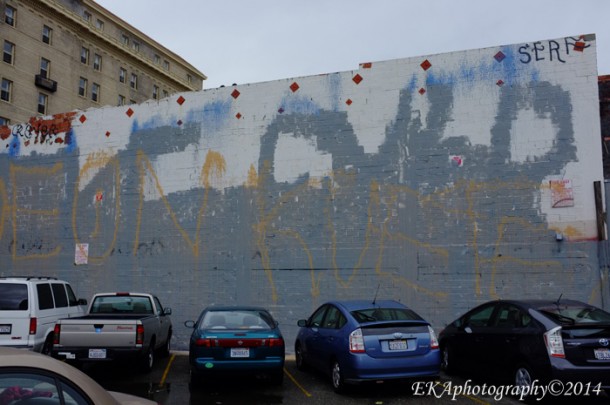
Ineffectual abatement plagued the wall at 14th and Alice for years
Our policy work has largely come about as an outgrowth of our on-the-ground efforts and our background as aerosol artists and reporters; We maintain that effective public art policy cannot be conducted if participants are removed from the communities they cover, ignorant of the realities of the artist subculture, or unschooled in local history and case studies from around the country.
Way back in 2011, we opined about the efficacy of murals vs. buffing walls. Buffing walls as graffiti abatement, we wrote, “fails to address some of the long-term solutions to urban blight,” noting further that “even if tagging temporarily declines due to a diligent ongoing effort, it will return when that concentration lets up.”

CRP’s Afrikatown mural was part of an extensive community beautification effort
These observations not only remain true today, but are consistent with the most recent Department of Justice guidelines on graffiti, which note that removal methods are “time-consuming and can be quite expensive” while describing private abatement efforts as “publicity campaigns… of limited effectiveness.”
On the other hand, the DoJ position on murals is that they are respected by vandals, “showcase artists’ work and may reduce incentives to vandalize,” and “may be effective in reducing the amount of graffiti in specific locations.” Again, such findings are consistent with CRP’s positions.
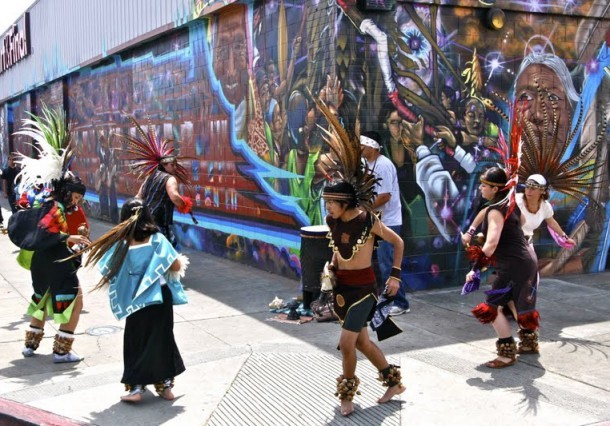
The “Peace and Dignity” wall has eliminated tag recidivism in a former hotspot
In 2012, we raised concerns about Oakland’s proposed anti-graffiti ordinance, which we said “is problematic on a number of levels.” We also noted, “many questions around implementation and enforcement remain.”
We cited case studies such as Los Angeles, where professional muralists were targeted by anti-graffiti units; Richmond, where legal murals were buffed by overzealous abatement crews whose income was dependent on graffiti removal; and state Proposition 21, which raised fines for young offenders to the tens of thousands but failed to reduce the graffiti problem. We wrote, “The lesson of Prop. 21 should be that punitive measures which target youth simply don’t work. On the surface, Oakland’s anti-graffiti ordinance appears to be just that.”
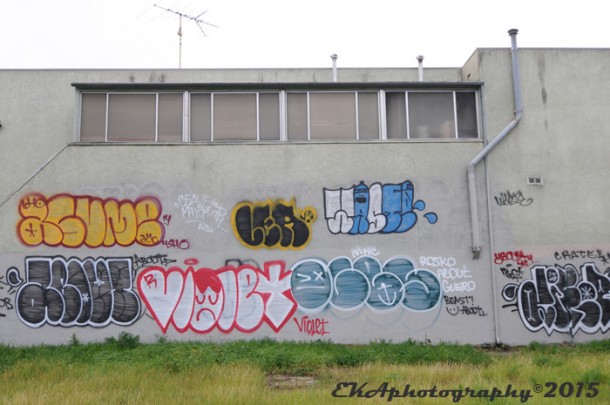
Oakland’s anti-graffiti ordinance has had zero impact on reducing tag vandalism
Despite reservations that the law was deeply flawed and basically unenforceable as written, the City Council unanimously passed it. Three years into the anti-graffiti ordinance, it is clear that it is a massive policy failure in almost every way. Not a single progress report has been presented before the Public Safety Commission; not a single vandal has been charged under its provisions; and not a single dime has been raised to compensate business owners victimized by vandals. And all indications point to the fact that graffiti in Oakland is on the rise; about the only good which has come from the ordinance was the creation of a $400,000 abatement mural fund, of which just $14,000 had been commissioned as of April 2015.
In 2013, we addressed the ominous encroachment of the abatement-industrial complex via the International Zero Graffiti Conference which provided a platform for a $17 billion-dollar industry consisting mainly of law enforcement employees, civil servants, and graffiti consultants –some of whom were hawking their profitable lines of side hustles: graffiti-resistant paint and cleaning products.
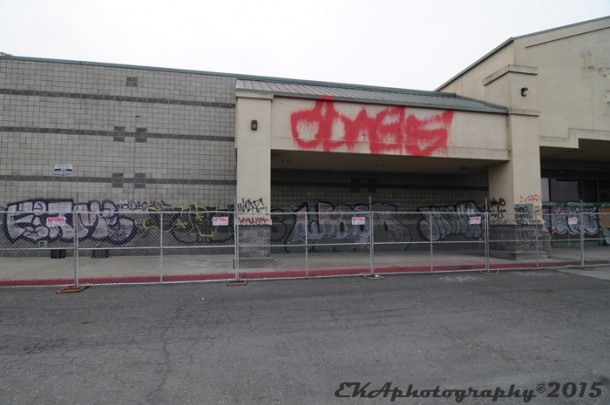
City abatement spends $1m annually, yet doesnt address private property
CRP noted that the IZGC organizers omitted murals and mural diversion programs in their strategies, despite an increasing body of evidence which shows these methods may be more effective and cost-efficient than current approaches favored by the industry, in favor. Speakers included Drew Linder, who sells a line of abatement products called This Stuff Works, and Mohammed Nuru, the controversial head of SF’s Public Works department, which has failed to limit graffiti despite spending more than $20 million per year in abatement costs.
In 2014, we outlined the advantages of abatement murals over buffing for businesses, noting, “painting out the problem often just invites more taggers, particularly if the clean-up does not include colors that match. Adding to the problem is the fact that city graffiti removal crews will only repaint public property, and businesses which are frequently tagged by vandals can face fines in some cases if they don’t paint over the unsightly tags quick enough. This never-ending cycle of vandalism and ineffective abatement can become a gateway for further criminal activity, and is particularly detrimental to small business owners who may not have the resources to abate graffiti tags expediently.”
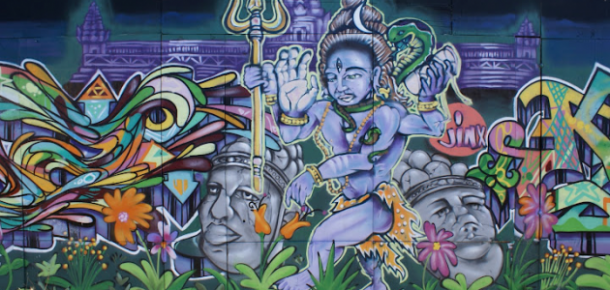
CRP teamed with the mayor’s summer jobs program and community organizations to paint 5 murals, including this one, in 2009
Given the realities of the abatement industry and its disinterest in promoting holistic solutions, CRP was naturally skeptical when we heard about a new beautification and graffiti abatement effort in East Oakland centered around a politically-connected construction company, with participation from law enforcement, corporate businesses, transit agencies, municipal employees, and the same City Councilmembers who have repeatedly shown disinterest in public art.
Our first thought was, where is the artist community? As it turns out, their participation was limited to a presentation at one meeting of the group, which calls itself the East Oakland Beautification Council, when an artist advocacy group, Safe Passage, told the assembled suits and uniforms that murals should be part of a comprehensive abatement strategy, but that muralists need to be paid for their efforts.

EOBC abatement efforts have been temporary and unsustainable
There is no further record of Safe Passage’s involvement with the EOBC, whose chairman Ken Houston went from advocating for “positive” interactions with youth artists, to declaring himself “militant” on graffiti, to touting a phone app he developed for law enforcement to help build cases against vandals, in the space of just over a year.
The EOBC has claimed to be a community service organization, although many of its supporters, including Houston, are developers. Under Houston’s direction, it’s also claimed a 75% reduction in graffiti in one section of East Oakland through a nine-month abatement effort, although it has yet to provide any supporting data backing up its claims, as CRP recently pointed out. The EOBC’s efforts, which have attracted considerable media attention but provided few specifics into methodology used, seem to fall under what the DoJ terms anti-graffiti publicity campaigns: dependent on volunteer labor and/or corporate subsidies, with predictable and temporary results, but unsustainable over time.
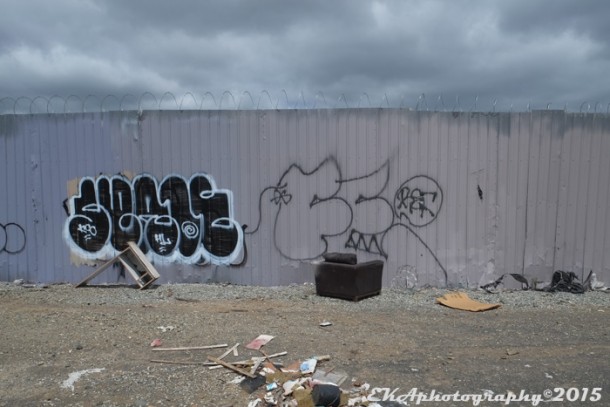
EOBC’s 9-month abatement campaign provided only short-term success in the San Leandro corridor
Not only has Houston refused to consider murals as part of a comprehensive abatement strategy, he’s claimed they are not effective deterrents to the proliferation of graffiti, despite considerable evidence to the contrary. Instead, he’s championed the ill-advised “Graffiti Cove,” an unsupervised free wall which appears to glorify tagging – a direct violation of DoJ guidelines. “Create your art here,” Houston says in a KRON-TV segment. “We’re going to embrace you. We’re going to showcase your art,” he adds.
We have to wonder why a guy hawking a graffiti-snitch app (from which he presumably draws revenue), who is himself a developer whose firm has received questionable and lucrative city contracts, would think that it’s possible to proactively engage youth vandals while simultaneously attempting to profit from their criminalization. But mainly, we have to point to the abatement-industrial complex’s track record of expensive inefficiency, and wonder why people like Houston keep trying to present old, tired strategies as if they are brand new.

This panda mural by Crayone in Chinatown upholds cultural heritage while deterring tagging
For example, Houston’s proposed panacea for bringing vandals to justice, a phone app specifically marketed toward law enforcement and municipal employees called “Erase & Buff,” appears to be quite similar to existing software called Graffiti Tracker, already in use in numerous US cities. Oakland residents have also been using a free app called SeeClickFix to report tagging and illegal dumping to Public Works officials (who then refer cases on private property to Code Enforcement) since at least 2012.
However, the fact that there are still open cases from four years ago in the SeeClickFix app logs would seem to suggest that such measures are largely ineffective. Moreover, it’s unlikely that “Erase & Buff,” which catalogs tags and automatically files a police report, would be any more effective than the programs already in use, nor result in a significant increase in vandalism arrests.

Abatement apps havent resulted in a decrease in tagging, nor increased enforcement
That’s because, as the East Bay Express recently reported, “Oakland police detectives… don’t even attempt to investigate most crimes, other than homicides and sexual assaults.” In fact, 80 % of Oakland’s robberies and 97% of burglaries went uninvestigated, the Express reported. Graffiti, obviously, is a far-lower priority.
The lack of enforcement explains why tacking on additional punitive measures to existing laws, as the anti-graffiti ordinance did, has had no impact whatsoever in reducing tag vandalism. It also explains why abatement efforts are ultimately doomed to fail, since Public Works is backlogged, Code Enforcement will only levy fines against property owners, and OPD won’t investigate graffiti crimes, even if police reports are filed.

Taggers in Chinatown have left this mural by Luqman X untouched
For those reasons, policy strategists and elected officials need to realize that you can’t keep beating a dead horse and expect it to win a race. Pretending that zero tolerance and tough-on-crime policies work hasn’t actually made those policies work. It would be cost-prohibitive to put enough resources into abatement to make a difference, assuming the cooperation between various city departments and private abatement firms could be maintained at any level of efficiency, which is also a longshot. And yet, Oakland continues to spend more than $1m a year on graffiti removal, while the abatement industry has grown to $20 billion in annual profits since the IGZG conference just three years ago.

Detail of Alice St. Phase I
Instead of literally throwing money away, isn’t it time to consider alternate strategies, such as the ones CRP has proposed? At this point, a comprehensive abatement/public art strategy employing murals as vandalism deterrents is perhaps the ONLY thing which could conceivably reduce tagging and tag recidivism.
The bottom line is that abatement efforts and public art strategy must become intersectional for city policy to move forward in both areas. We don’t need any more self-styled graffiti experts claiming community while looking to line their own pockets, just as it makes little sense to enact more punitive measures when enforcement is practically nonexistent. And we also don’t need any more flawed policies which purport to solve an issue, only to be ineffectual and/or expensive.
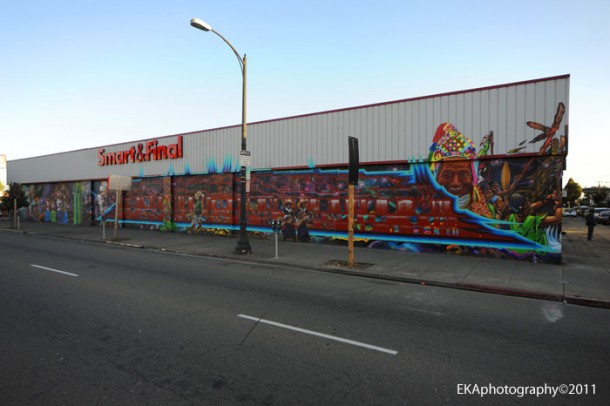
Abatement murals have proved more cost-effective over time than continual rebuffing
We do need to explore mural diversion programs as part of restorative justice measures and enact city-wide mural campaigns in Oakland’s most blighted neighborhoods. We need a mural registry initiative to prevent unsanctioned buffing of legitimate art. We need artist organizations with expertise in community engagement and creating effective models to be at the table when abatement solutions are discussed. And we need elected officials to realize that quick-fix band-aids for complex civic problems rarely work, and often only make things worse.

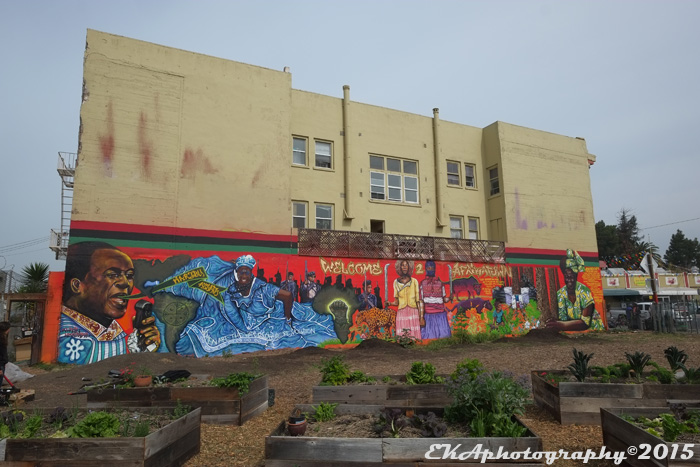
One comment